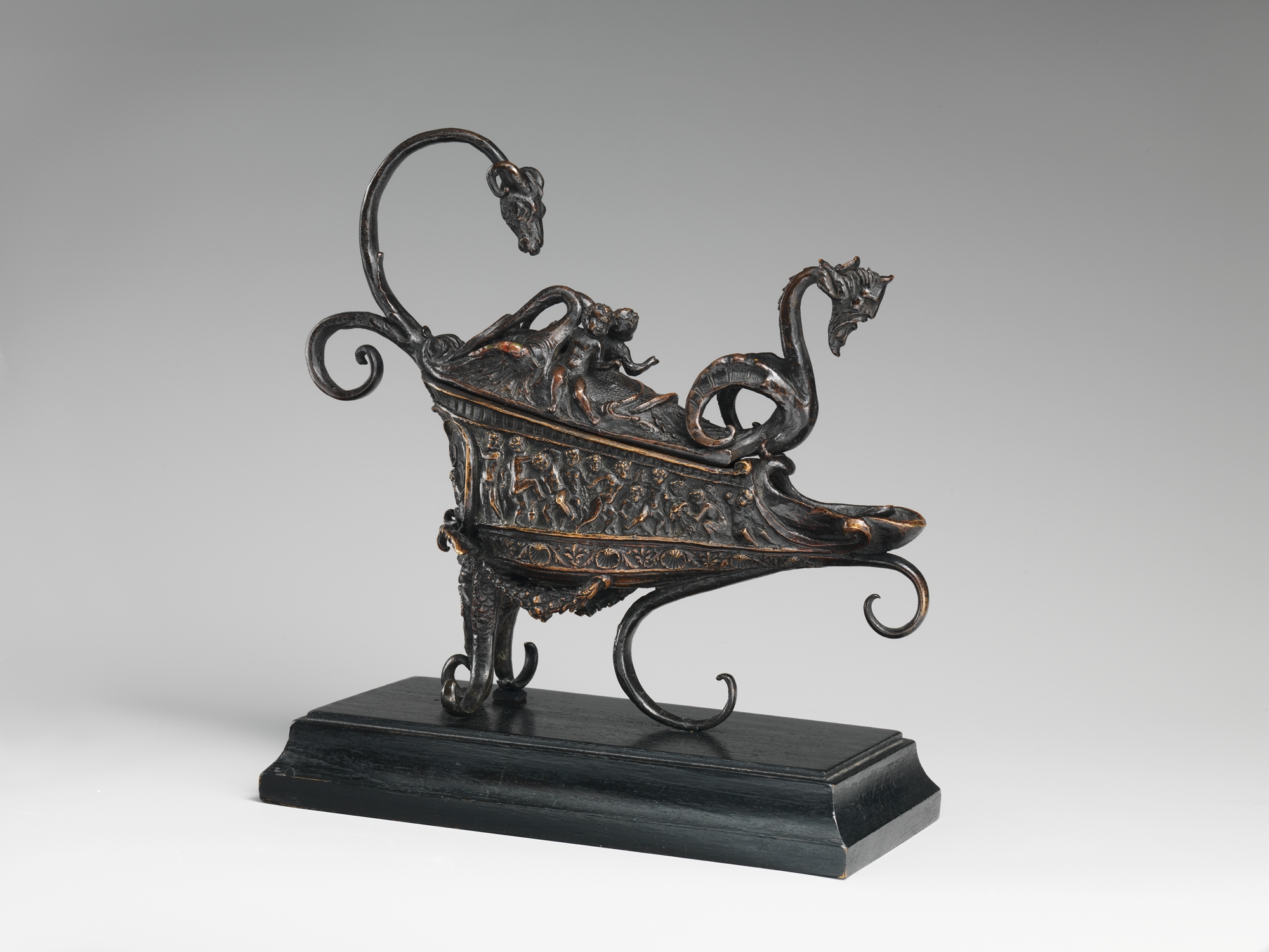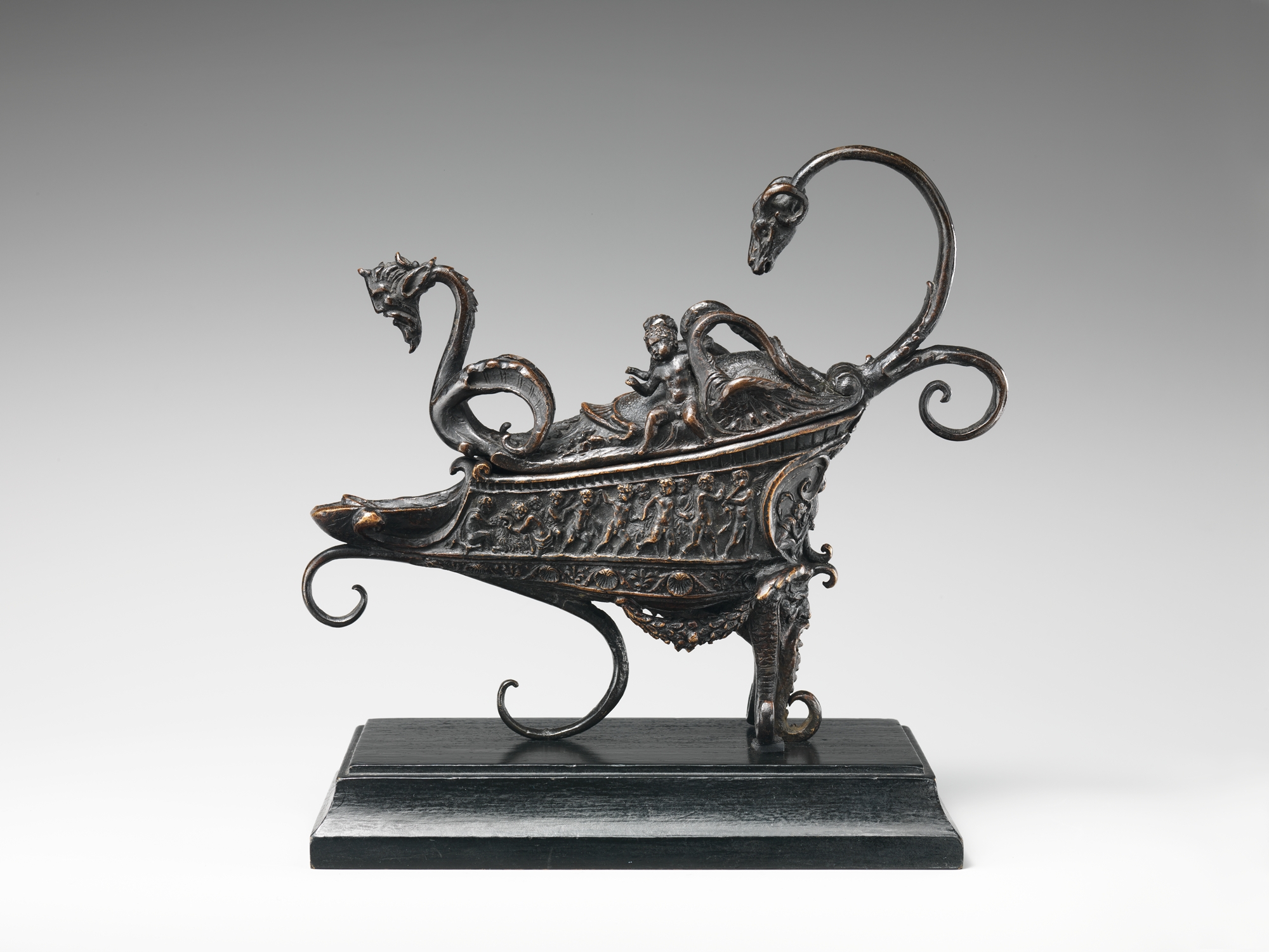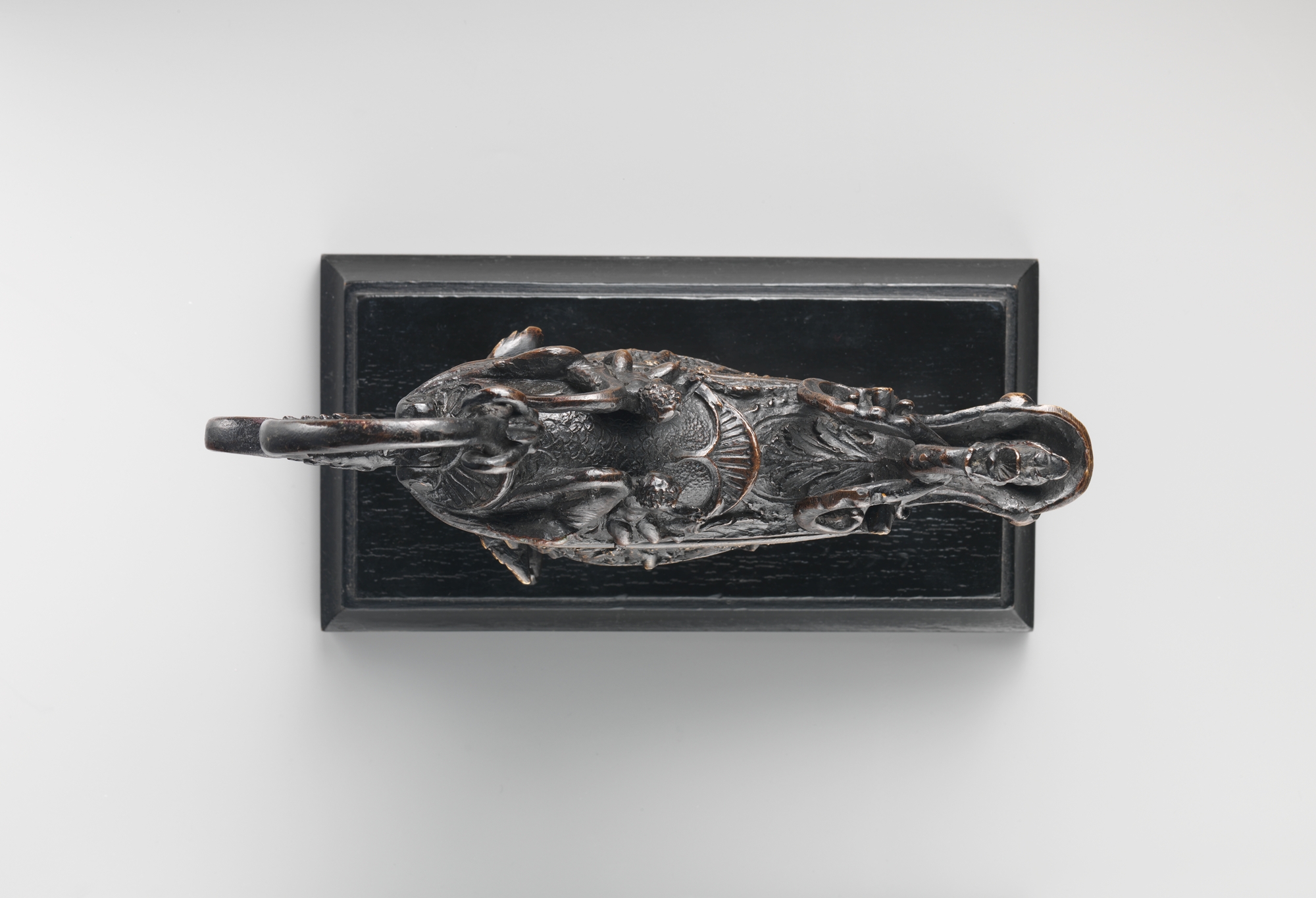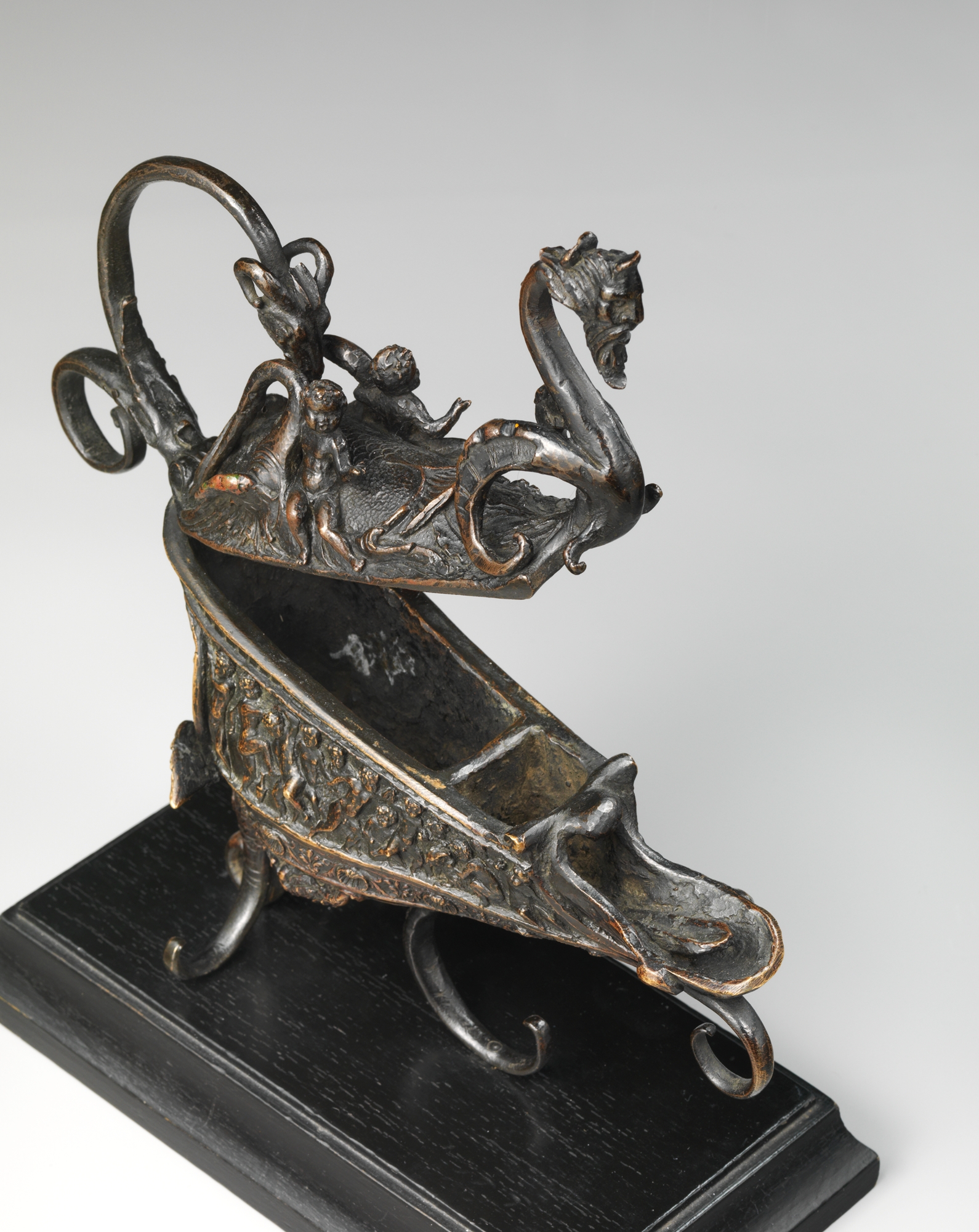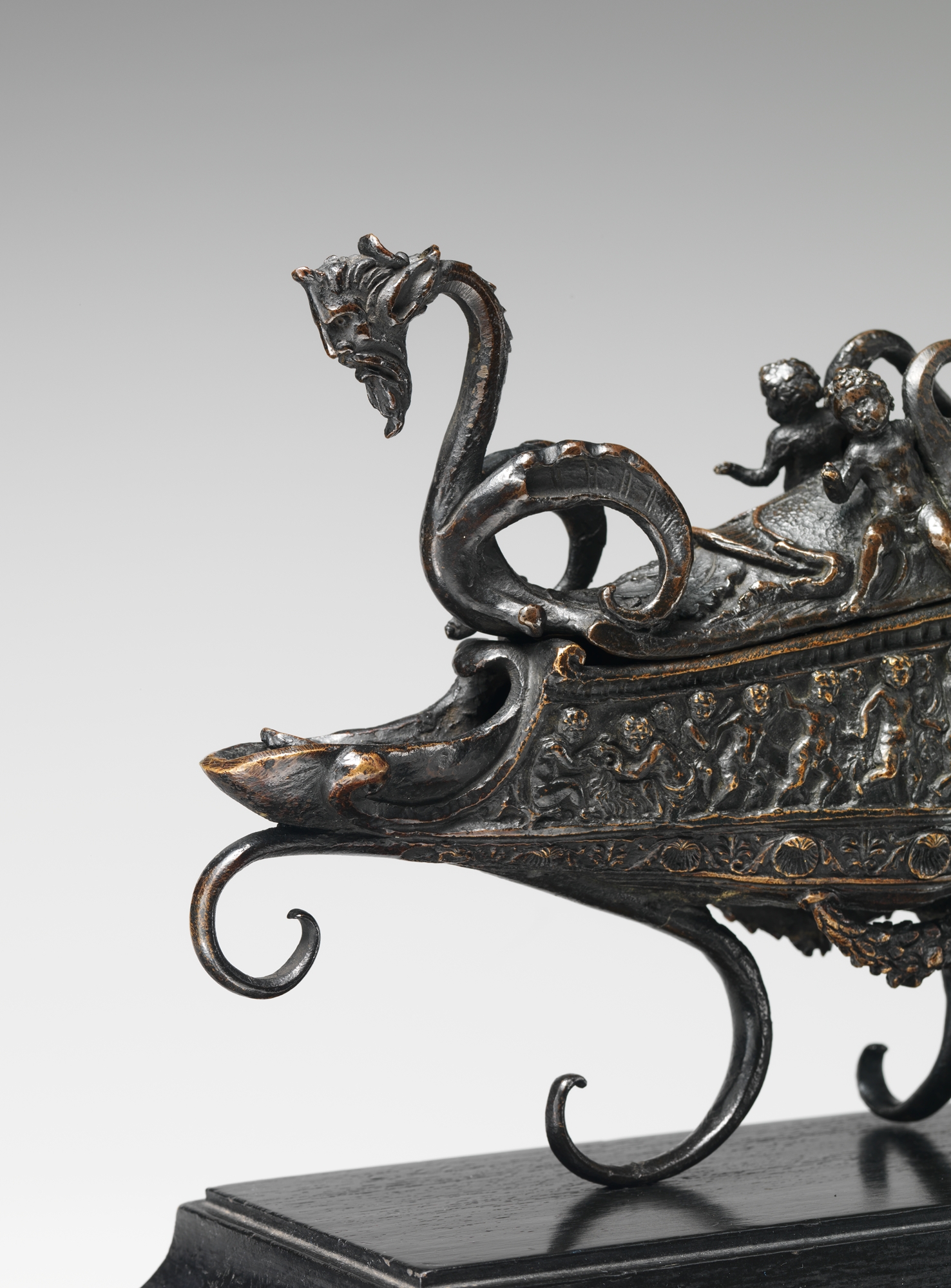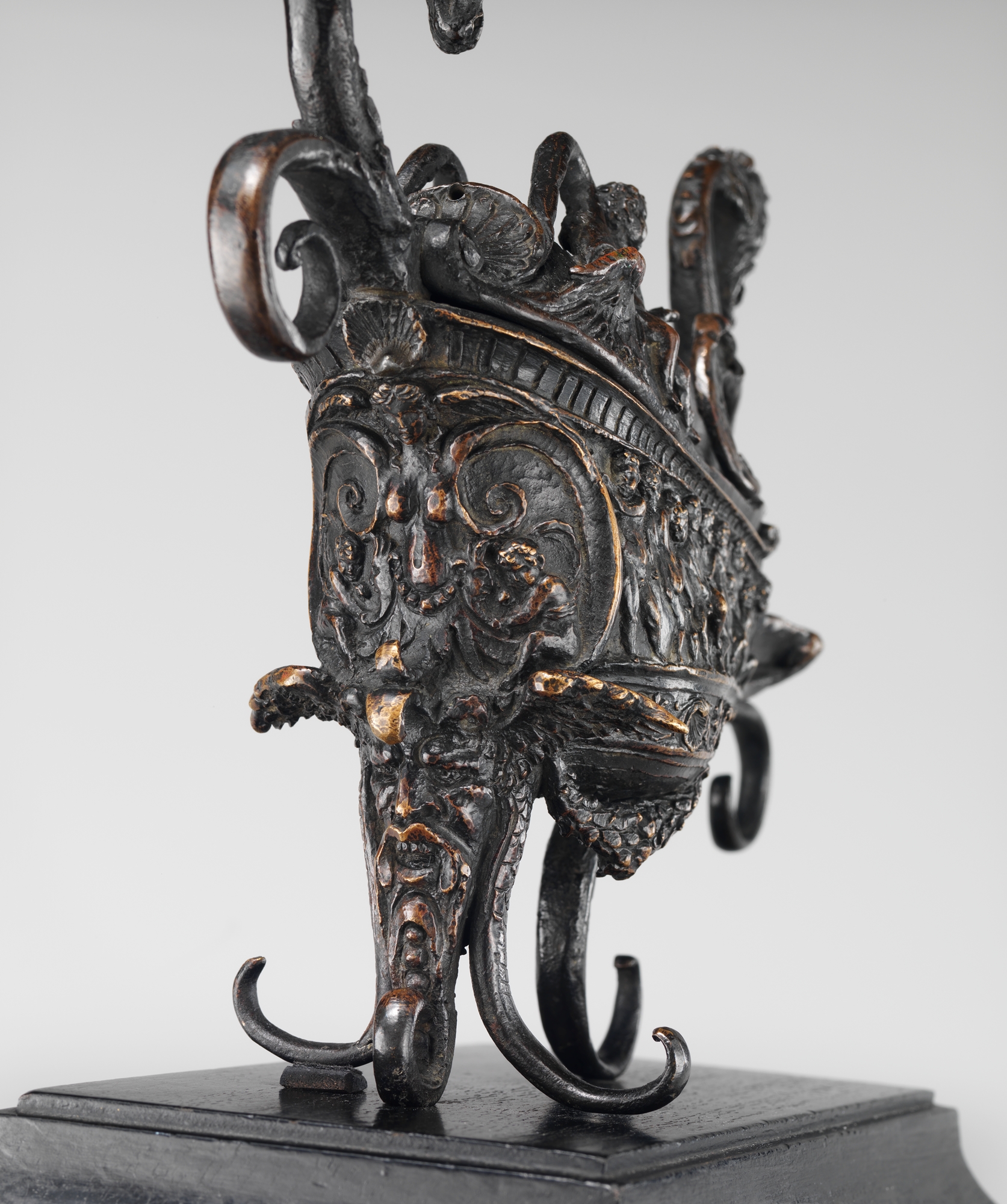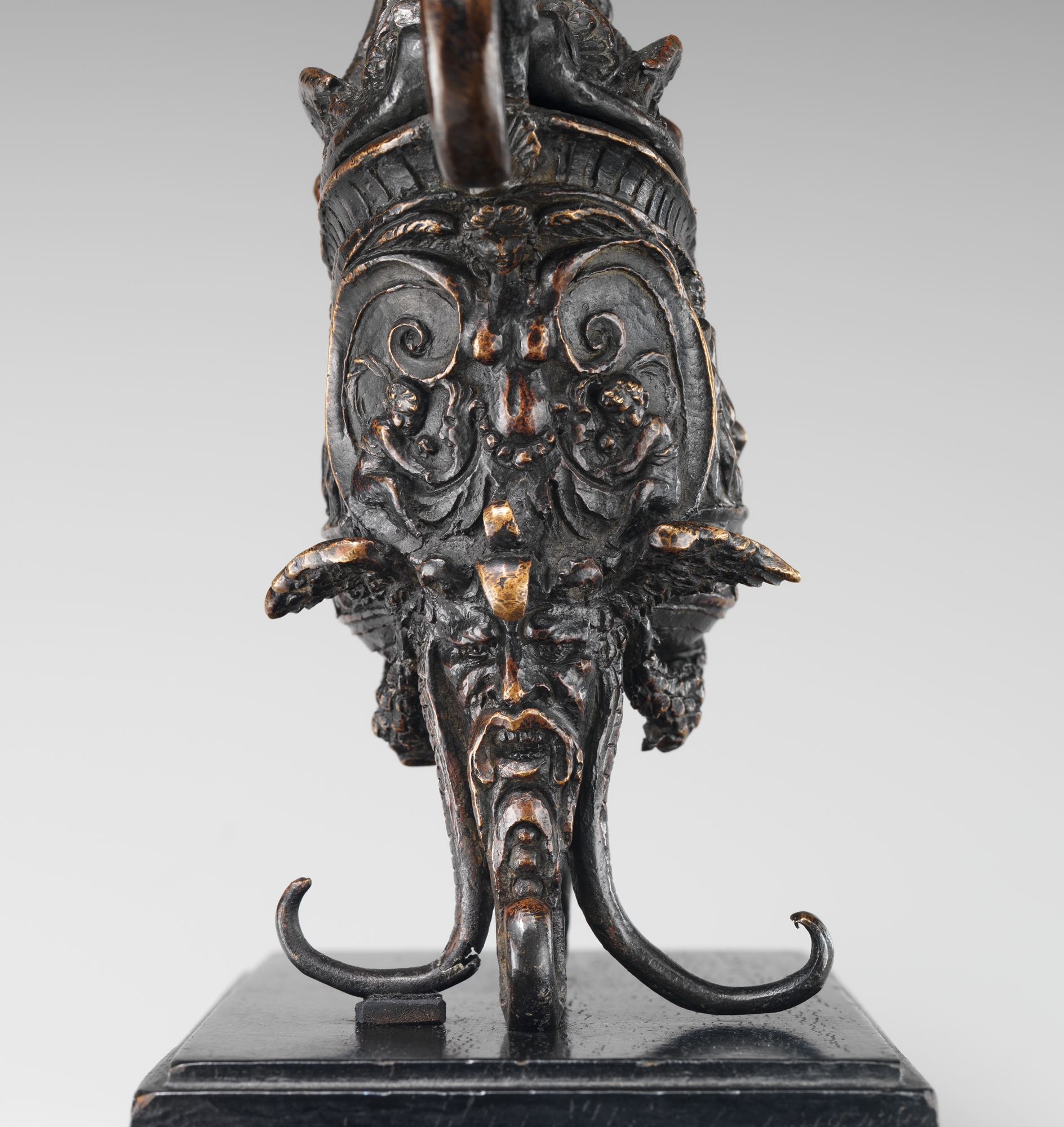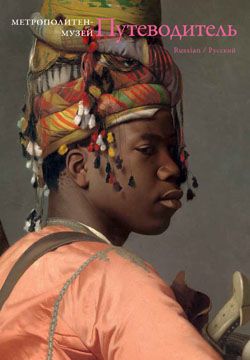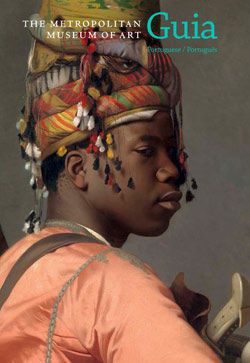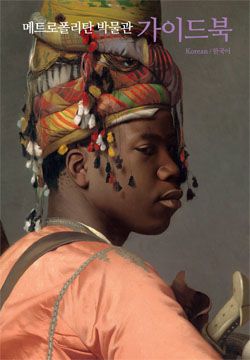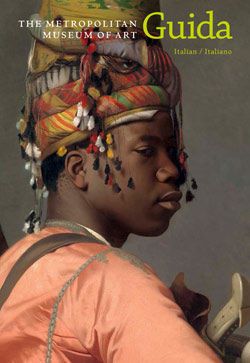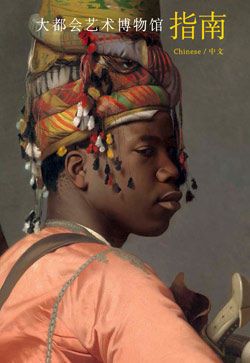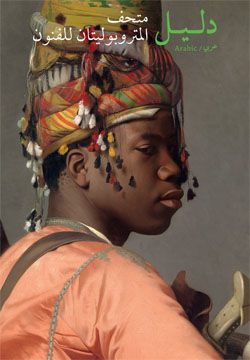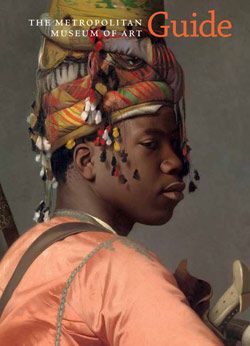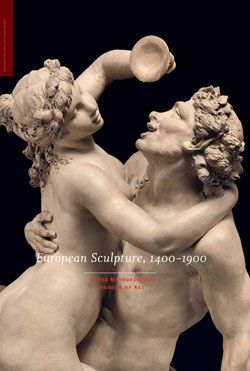Rothschild lamp
Andrea Briosco, called Riccio Italian
Elegantly lofted on four coiling tendrils, the body of the Rothschild Lamp balances in midair with a dynamism unrivaled in Renaissance bronze sculpture. The oblong vessel promises to hold a generous quantity of oil, tapering gently to present an opening for a wick. Presiding above this aperture is a pointy-eared satiric head, which is perched on a long neck that morphs into the lid of the lamp. The lid sprouts organic forms of vegetal and animal origin. Acanthus leaves lead back to a fluted visor that gives way to a scaly surface from which emerge two wings. At the base of each wing is a long neck that twists backward and disappears under a shell-like ornament. The horror of such headless redoubling is countered by the mirth of two putti that grasp each neck for support. Behind the juncture of lid and hinge springs a handle of two diverging spirals, the higher terminating in a ram’s head that drives attention back to the center of the lamp.
Perfectly fitted to its lid, the lamp receptacle is decorated on both sides with friezes of putti in Bacchic celebration. At the rear of the vessel is a siren bedecked with a pair of tiny wings, her appendages transforming into ornamental curls that frame putti playing with masks that flank her hips. Below emerges a triad of tendrils to support the lamp. The tendril formation widens in the center to feature a drooping, open-mouthed face with furrowed brows. The siren and face meet to form two oppositional curls, and alongside them protrudes a set of avian wings. As if nothing more could fit at this juncture, a pair of garlands is affixed beneath the wings, and their gentle arc returns the viewer’s gaze to the center of the lamp. Each aspect of the bronze’s design thereby competes for the viewer’s attention but also redirects it to other decorations, the curvaceous forms reinforcing this inescapable circuit. Given that its maker, Andrea Riccio, was named for his celebrated curly hair, he announces his mastery of bronze through the lamp’s signature excess of curling appendages.[1]
Riccio’s sculptural prowess is likewise evident in the technical features of the lamp’s construction. Arriving at The Met in near perfect condition, the Rothschild Lamp was made of two separately cast parts: the lid and the container.[2] The lamp was cast directly, appropriate to its bespoke design and Riccio’s working methods. Its intactness defies its apparent delicacy, although there are two riveted lap joins on the lateral, proper left tendril among the triad, as well as on the central tendril. These appear to be original to the lamp’s making. Examination using X-ray fluorescence indicated that the foot, body, and lid share the same metal composition. The interior of the lamp bears two separate chambers for a wick, as well as a rough texture commensurate with many of Riccio’s other bronzes.[3]
Riccio arrived at the perfection of the Rothschild Lamp through the development of other bronze lamps across his career.[4] He made several small oil lamps similar to surviving antique prototypes, but the two closest to ours are the Cadogan Lamp in the V&A and the Oil Lamp in the Frick.[5] The Cadogan Lamp, presumably the first of the three, is balanced on three curling tendrils, and its acanthus lid with a putto riding a porpoise clearly informed Riccio’s later work. Similarly evocative of the Rothschild Lamp are the Cadogan Lamp’s shiplike shape and the zoomorphic forms that ultimately overtake its structure.[6] Indeed, the Cadogan Lamp seems to enact a metamorphosis into grotesque forms before the viewer’s eyes, and it is this principle that Riccio carried forward to his subsequent projects.[7] The Frick lamp is awash in ornate decorations on every outer surface, including its underside. Its design is closer to our lamp, a narrative frieze of putti stretching around the entire body of the vessel. While the Cadogan Lamp gives privileged space to medallions with powerful moral messages, the Frick lamp thrives on the interrelationships between ornamental motifs, the putti’s uninterrupted Bacchic sacrifice, and the apotheosis promised by a lit flame.[8] In the Frick lamp, as in his magisterial Paschal Candelabrum, Riccio yoked form, function, and imagery in a manner that was especially instructive for the program of the Rothschild Lamp.
The Met’s lamp combines and elaborates grotesque motifs to show Riccio’s playful mastery of ancient ornaments. This is exemplified by the siren motif at the back of the receptacle adapted from the Cadogan Lamp.[9] Riccio’s association of the siren with scaled tendrils below finds a parallel in contemporaneous Paduan bronzes of a siren-shaped, eagle-footed candelabra type popularized in Severo da Ravenna’s workshop.[10] This motif may also have been inspired by a woodcut illustration of a hanging lamp in Francesco Colonna’s Hypnerotomachia Poliphili (1499).[11] With its bilateral symmetry spanning a gradual curve, the back of the Rothschild Lamp echoes Riccio’s Carrand Vessel (Bargello); both feature central grotesque masks that, while different in appearance, signal Riccio’s facility with inventing such forms.[12] Members of Riccio’s Paduan circle of humanist friends would have readily appreciated his grotesque innovations, among them Niccolò Leonico Tomeo, a professor of Greek philosophy who collected antiquities featuring hybrid beings.[13]
Among those best poised to discuss details of the Rothschild Lamp was the Neapolitan humanist Pomponius Gauricus. His magisterial treatise De Sculptura (1504) notes his friendship with Riccio, and its invective against modern sculptors who choose hybrid creatures, instead of the human body, as their subject matter is difficult to reconcile with the Rothschild Lamp’s deployment of grotesque forms.[14] This criticism echoes a range of ancient authors, notably Horace and Vitruvius.[15] In an arena where Riccio and his friends readily discussed these ancient texts, the Rothschild Lamp was the ideal conduit for conversation and debate. While the lamp’s use of grotesques could be seen to run counter to Gauricus’s famous argument, it is rather the perfect artistic riposte to inspire further discourse around decorum and license.[16] The bronze’s status as a lamp made it an apt vehicle for grotesque imagery, given the paucity of extant antiquities of this caliber and extensive descriptions of them in texts such as the Hypnerotomachia Poliphili.[17]
Such discourses rooted in the language of antiquity connected to another area of interest in Renaissance Italy: the interpretation of hieroglyphs. The vogue for this nascent field at the turn of the sixteenth century furnished an interpretive mode for a pictographic language with embedded sacred wisdom.[18] The enigmatic motifs across the Rothschild Lamp would have invited such a system of thinking; Riccio translated hieroglyphic elements from two to three dimensions in harmony with Gauricus’s comment that the graphic art of the Egyptians revealed how writing was synonymous with painting and sculpting.[19] The Veneto was a key center of hieroglyphic studies: the first Greek edition of Horapollo’s Hieroglyphica was published by Aldo Manuzio in 1505 and subsequently translated, expanded, and Christianized by Pierio Valeriano, a student of Tomeo in Padua. Ekphrastic descriptions of lavish vessels coupled with hieroglyphic illustrations and interpretations in the Hypnerotomachia Poliphili further conditioned understandings of the Rothschild Lamp.[20]
Viewers of the lamp would have brought a more linear mode of reading to the narrative reliefs of putti on its lateral sides, which are similar but not identical. Both scenes taper gently as they approach the spout, the putti at the narrowest region seated in order to keep them all to equal scale. The proper left relief shows twelve putti, the three nearest the spout preparing a goat for sacrifice while eight adjacent link arms in dance. The lamp’s only winged putto, that at the far right, plays a pipe.[21] A similar scene unfolds on the other relief, with seven putti dancing as three at right prepare to sacrifice a goat. Here, an additional putto sits at the tip of the relief near the spout, gesticulating toward his comrades, and a wingless putto standing at the far extreme blows his pipe away from the group. These reliefs recall ancient sarcophagi with putti engaged in Bacchic rituals, but the complexity of their tapered format enables Riccio to outstrip antique sources.[22]
The Rothschild Lamp’s Bacchic reliefs compete not only with antiquity, but also with Riccio’s sculptural forebears: Donatello was famous for reviving this ancient type in Christian contexts, serving as the progenitor to his bronze angel reliefs on the altar of the Santo in Padua.[23] Riccio nodded to this through the Bacchic procession of putti atop his Paschal Candelabrum in the same basilica, the overlay of Christian imagery and pagan sacrificial altars a crucial feature of the candelabrum’s program.[24] The Rothschild Lamp reinforces these associations by evoking a pagan altar through its ornamental motifs, its burning evocative of ritual sacrifice.[25] The putti in Riccio’s lamp could thereby be read as a Neoplatonic metaphor for salvation of the soul through ecstasy toward the divine.[26] Renaissance associations of putti as genii and spiritelli also linked them to the Aristotelian concept of the spirit (pneuma), the putti’s Bacchic ritual promising the lamp’s owner a transformative ecstasy that would reach its acme in the apotheosis of the burning flame.[27]
In their similarity and fundamental differences, the reliefs of putti on the Rothschild Lamp evoke and rupture symmetry. This aesthetic principle held particular interest among Riccio and his humanist friends in Padua, with Gauricus devoting the second book of De Sculptura to the topic.[28] He stressed that symmetry is applicable to all human bodies, with the caveat that it is not applicable to monstrous and dwarfed beings, followed by the observation that symmetry is evident in musical harmony.[29] Riccio evidently took Gauricus’s exclusion of monstrous beings from symmetry as a dare to deploy this precept across a symmetrical object laden with monstrosities. Gauricus’s subsequent comparison of symmetry to music signals its transmedial applicability, including within the ancient liberal arts. By deploying bilateral symmetry coupled with sly asymmetries, the Rothschild Lamp prompts a visual meditation on this organizing system across disciplines such as music and rhetoric.[30] Riccio was well aware that symmetry was an operative feature of grotesques, as playful divergences from it are also found in contemporary prints by Nicoletto da Modena, among others. Renaissance viewers attuned to symmetry could have compared the lamp’s two sides, whether by turning it or using a mirror, an implement common to scholars’ private spaces.[31]
The Rothschild Lamp was also fully functional as a light source within the studiolo. Whether enlivened by a burning flame or light from a window, the lamp and its swarming grotesques manifest the generative powers of nature at the heart of this bronze, a concept with deep resonances in Aristotelian natural philosophy.[32] In the university town of Padua, Aristotle was, to quote Dante, “the master of those who know,”[33] and his thought was synthesized with Christian theology and Florentine Neoplatonism by the likes of Tomeo.[34] Plato believed in a demiurgic God who created the four elements from chaos.[35] This cosmological understanding, further developed by Aristotle in On Generation and Corruption, was integrated with Aristotle’s notion of pneuma as the sustaining principle of the world, a vital heat that grants life to elemental matter.[36] This explains the preponderance of wings in the Rothschild Lamp, most notably the winged grotesque mask at its base, whose exhalation seems to spontaneously generate the surrounding foliage. The hinged lid of the lamp can be interpreted as a composite creature hewn from pneuma and all four elements: the shells and scales indicate water, the arabesque-like fronds emerge from an earthy substructure, and the satiric head at the tip seems to expel air from its open mouth, kindling the fire at the lamp’s spout. Finally, this notion of the lamp’s self-generation mirrors the artist’s inventive ability to give form to material, as analogized by Aristotle.[37] Illuminated by the flickering glow of the fire in the cloistered studiolo, Riccio and his humanist friends would have witnessed this static bronze transform into an animated zoomorphic being, redolent of antiquity, but ever-evolving in form and meaning.
-RC & AF
Footnotes
(For key to shortened references see bibliography in Allen, Italian Renaissance and Baroque Bronzes in The Metropolitan Museum of Art. NY: The Metropolitan Museum of Art, 2022.)
1. On Riccio’s adoption of his nickname and visual commemoration of his curly locks in a small, self-portrait bust, see Allen 2008b, p. 15.
2. The following technical details derive from R. Stone/TR, December 31, 2008.
3. On the interior texture of Ricco’s bronzes as an indicator of his authorship, see Stone 2008. 4. The Rothschild Lamp’s workmanship and combination of features from the other lamps discussed here suggest that it could have been the last made among them. For a proposal that it definitively predates the Riccio lamp in the Frick, see Radcliffe 1972, p. 49. The Frick lamp bears a greater amount of decorative elements, but the streamlined construction and unity of form of the Rothschild Lamp suggest a judicious application of a lifetime of experience.
5. The Rothschild Lamp is among six extant bronze lamps widely ascribed to Riccio. In addition to the Cadogan and Frick lamps, the others are: the Fortnum Lamp, Ashmolean, WA1888.CDEF.B1100; Oil Lamp, Bargello; and Three-Wick Lamp with Bacchic Scenes, National Gallery of Art, Washington, D.C., 1957.14.66. A number of other lamps very near to Riccio in style bear attributions such as “school of Andrea Riccio,” on which see recently Malgouyres 2020, pp. 242–55.
6. The ship form nods to the dual significance of the Latin word rostrum for a ship’s prow and lamp spout; see Radcliffe 1972, pp. 29–35, 44. On the hybrid, zoomorphic features of the lamps, see Frosien-Leinz 1985, p. 242.
7. Peta Motture in Allen 2008a, p. 181.
8. See Allen 2008a, pp. 174–89, cats. 13, 14. See also Motture 2019, pp. 182–83.
9. Radcliffe 1972, pp. 45–46. The chief difference between the female grotesques of the Cadogan and Rothschild lamps is the latter’s incorporation of two boys dressed in sailcloth facing the masks.
10. For Severo’s hybrid candelabrum, see Jeremy Warren in Padua 2001, p. 167, cat. 38.
11. Colonna 1999, pp. 206–7. It has been suggested that the siren signify poetic eloquence, appropriate for an object that offered the light of knowledge in the scholar’s study. See Luchs 2010, pp. 166–67, for further references on other positive aspects of the siren.
12. Radcliffe 1972, p. 47; Allen 2008a, pp. 194–99, cat. 16A.
13. Favaretto 1979, pp. 18–19, 21–27.
14. Gauricus 1999, p. 140. Gauricus refers to Riccio as “familiaris meus” (my friend). Ibid. p. 254.
15. Ibid., p. 268.
16. On license and the grotesque, see Hansen 2019, pp. 64–65.
17. Colonna 1999, pp. 206–7. There are notable surviving examples of premodern bronze lamps that could serve as precedents for Riccio’s design, such as the Byzantine Standing Lamp with Running Dogs, MMA, 62.185.
18. For a history of Renaissance hieroglyphic studies, see Volkmann 2018; Giehlow 2015; B. Curran 2007; Dempsey 2001 (all with bibliography).
19. Volkmann 2018, p. 59. The two medallions on the Cadogan Lamp, for instance, can be read hieroglyphically; see Motture in Allen 2008a, pp. 177–79.
20. Colonna 1999, pp. 109–16; Frosien-Leinz 1985, pp. 226–41.
21. Riccio’s inclusion of a single winged putto on the lamp could identify this figure as Genius or Eros, a figure endowed with gifts by Fame in plaquettes ascribed to Riccio (National Gallery of Art, Washington, D.C., 1957.14.347, 1957.14.349). On this type of plaquette in relation to the broader traditions of putti, see Pfisterer 2002, p. 165.
22. For examples of ancient sarcophagi, see Bober and Rubinstein 2010, pp. 101–2.
23. On Donatello and putti, see Struthers 1992; Dempsey 2001, pp. 1–61; Pfisterer 2002, pp. 111–83; Morel 2014, pp. 537–67. In the Veneto, the Lombardo workshop further appropriated this motif: Morel 2014, pp. 601–11.
24. On the imagery of sacrifice in the Paschal Candelabrum, see Morel 2014, pp. 712–15; Banzato 2008b; Blume 1985a, p. 105. On the broader joining of Bacchic and Christian imagery in the Renaissance, especially in relation to altar images, see Nagel 2000, pp. 87–99.
25. Denise Allen in Allen 2008a, p. 188.
26. On such Neoplatonic ideals in relation to the Paschal Candelabrum, see Blume 1985a, pp. 111–12.
27. This discussion draws from Denise Allen’s analysis of the Frick lamp in Allen 2008a, pp. 185–88.
28. Gauricus’s discourse on symmetry was informed by a host of classical texts by Plato, Vitruvius, Cicero, and others. See Gauricus 1999, pp. 152–69.
29. Ibid., pp. 158–59.
30. On symmetry in Italian Renaissance art, see Summers 1977.
31. Thornton 1997, pp. 167–74.
32. In addition to the philosophical underpinnings of such metamorphoses, the lamp’s transformative properties may also have engaged popular interest in magic and occult mutations of materials. See Battisti 1962, p. 170; Frosien-Leinz 1985, pp. 251–55.
33. “’l maestro di color che sanno.” Inferno IV:131.
34. See Banzato 2008b, pp. 43–47, for the key figures and intellectual ideas that rippled in Riccio’s humanist circle in Padua.
35. Plato, Timaeus, 48A–C, 53A–B. This depiction of the four elements can also be found in the reliefs on the lowest register of the Paschal Candelabrum; Banzato 2008b, pp. 49–53, figs. III.7A–D.
36. Aristotle discusses pneuma and the spontaneous generation of plants and animals in On the Generation of Animals (762a18); see G. Lloyd 2007, pp. 140–41.
37. Allen in Allen 2008a, pp. 186–87.
Due to rights restrictions, this image cannot be enlarged, viewed at full screen, or downloaded.
This artwork is meant to be viewed from right to left. Scroll left to view more.


